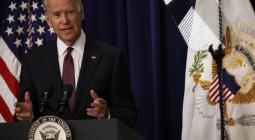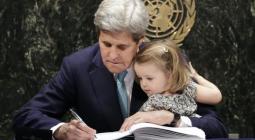What is the Paris Climate Agreement and when can Biden rejoin deal?

President-elect Joe Biden has vowed that among the first things he will do on entering the White House is rejoin the Paris Climate Accord, the international pact to cut global emissions and get a grip on the climate crisis.
President Trump withdrew the US from the non-binding agreement in 2017, calling it a “disaster” for America.
“I will join the Paris Accord because with us out of it, look what’s happening. It’s all falling apart,” he said during his first presidential debate with Donald Trump, pointing to the rampant destruction of Brazil’s rainforests, happening in the vacuum of US diplomatic leadership.
Below is a breakdown of the background, significance and future prospects of the Paris Accord - and what it will mean for the US to re-enter.
-
What is the Paris Climate Accord?
Accord, agreement, deal, goals, pact - call it what you will, it refers to one central aim, agreed upon by almost every nation in 2015, to avoid perilous climate change by dramatically reducing global greenhouse gas emissions heating the planet.
Countries set their own goals to try to curb global temperature rise, with a collective aim to stay well below 2 degrees Celsius above preindustrial levels, and pursue efforts to limit it to an increasingly aspirational 1.5C.
The consequences of the worsening climate crisis are happening all around us: Melting of polar ice caps, rising sea levels and extreme weather.
Countries’ current pledges are not enough to meaningfully tackle the climate crisis, so the Paris agreement calls for more ambitious targets, called Nationally Determined Contributions, being set every five years.
The Paris deal has a “ratchet mechanism”, meaning each nation must come out with a bolder target for reducing emissions every five years. Updated NDCs are expected by the end of 2020.
The Paris deal also provides pathways for richer countries to help poorer ones, some of which are already bearing the brunt of the climate crisis, to reduced their emissions and adapt to a rapidly-changing planet.
The human-driven climate crisis has already caused about 1.2C of global heating above pre-industrial levels. The World Meteorological Organisation said in July that there is a 20 per cent chance global temperatures will hit 1.5C in at least one year between 2020-2024.
-
What did the US agree to?
The US, the world’s second-largest emitter, pledged to reduce emission levels between 26-28 per cent by 2025 from 2005 levels. It is not on track to reach those goals.
The European Union pledged to cut carbon pollution in 2030 by 40 per cent from 1990 levels - a greater commitment than the US. The United Kingdom has already exceeded that goal, the AP reported.
A report by leading climate scientists in 2019 also found that of the 184 climate pledges, 128 were not on track to contribute to reducing emissions by 50 per cent by 2030, including India and China.
As part of the Paris deal, former president Obama pledged $3 billion toward the Green Climate Fund to help poorer countries adapt. Mr Trump moved to withhold $2bn when he became president.
In 2019, 27 countries announced contributions totalling $9.8bn. The US refused to contribute.
-
Why did Trump call the Paris agreement a ‘disaster’ for the US?
Mr Trump has repeatedly mischaracterized the terms of the agreement, which are voluntary. In October 2019, he called it a massive wealth transfer from America to other nations and dubbed it “one-sided”.
Mr Trump announced his intention to withdraw in June 2017, saying it was an end to “the draconian financial and economic burdens the agreement imposes on our country.”
After the announcement a group of interdisciplinary scientists published a report looking at the implications of withdrawing and suggested that by the end of the century, the US could be about 5 per cent poorer with about $8trillion in losses.
A report produced by the Organisation for Economic Co-operation and Development for the G20 also found that climate policy can boost growth and employment. The study indicated that G20 nations could see a 5 per cent increase in growth by mid-century with a strategies for carbon reduction and climate resilience.
“The US agreement is not a tax on the American people. There is no massive wealth transfer,” Climate Advisers CEO Nigel Purvis, who was a lead State Department climate negotiator in the Clinton and George W Bush administrations, told the AP. “In fact, the agreement obligates no country to make any financial payments.”
Regardless, on 4 November, 2019, the Trump administration formally notified the UN it would withdraw after the required one-year waiting period. (Part of the agreement was that no country could pull out in the first three years. Mr Trump did so on the first day possible.)
-
If Trump wins, what happens next?
The US officially withdrew from the global pact on 4 November, 2020, the day after the presidential election.
Mr Biden will not need the backing of the US Senate support to rejoin, as the accord was set up as an executive agreement.
Whenever his administration notifies the UN by letter that the US intends to rejoin, then it should officially take effect in 30 days.
After rejoining, it is expected that the US will need to submit updated emission reduction targets from the Obama goals, along with a plan on how it plans to do so.
“Global objectives can’t be met unless everybody does their part and the U.S. has to play the game,” Appalachian State University environmental sciences professor Gregg Marland, who is part of a global effort to track carbon dioxide emissions, told the Associated Press last year.
The US re-entering the Paris Agreement may see some jockeying for position on the global stage.
At a national level, the US has been largely absent from the climate community during the Trump administration, and in that time others have stepped up, most notably China.
Calling for a “green revolution”, President Xi Jinping announced at the UN General Assembly earlier this year a plan for China to reach carbon neutrality by 2060 and said the country would aim to have carbon emissions peak before the end of the decade.
And the US may be met with some skepticism.
Jonathan Pershing, the State Department’s special envoy for climate change during the Obama administration told the New York Times that the country would likely be faced with lingering distrust on the international stage.
The US has pulled a similar move in the past when former president George W Bush took the US out of the 1997 Kyoto Protocol, after it had been joined by his predecessor Bill Clinton.
The Associated Press contributed to this report
12 Δεκεμβρίου 2020
INDEPENDENT





